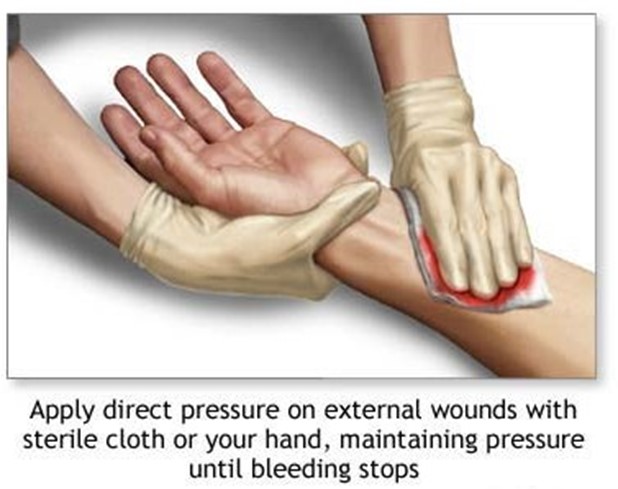A nurse in the emergency department is assisting with the care of a client who has a deep laceration on her left lower forearm and is bleeding heavily from the wound.
Which of the following actions should the nurse take first?
Apply a tourniquet just above the wound.
Place the client in a modified Trendelenburg position.
Apply pressure directly to the wound.
Settle the client in a reclining position.
The Correct Answer is C
This is the first step in controlling bleeding and preventing hematoma formation 1.
Applying direct pressure to the wound with a sterile gauze or a clean cloth can help stop the bleeding 2.

Choice A is not the best answer because a tourniquet should only be used as a last resort to control life-threatening bleeding from a limb 2.
Choice B is not the best answer because placing the client in a modified Trendelenburg position is not necessary for this situation.
Choice D is not the best answer because settling the client in a reclining position is not necessary for this situation.
Nursing Test Bank
Naxlex Comprehensive Predictor Exams
Related Questions
Correct Answer is A
Explanation
Protamine is a medication that can be used to reverse the effects of heparin in the event of an overdose.
It binds to heparin and neutralizes its anticoagulant effects.
Choice B is not correct because glucagon is used to treat low blood sugar, not heparin overdose.
Choice C is not correct because oxygen is not a medication and is not used to treat heparin overdose.
Choice D is not correct because insulin is used to lower high blood sugar levels, not to treat heparin overdose.
Correct Answer is C
Explanation
The nurse should set the flow rate to deliver 40 gtts/min.
This can be calculated by multiplying the infusion rate (120 mL/hr) by the drop factor (60 gtt/mL) and then dividing by the number of minutes in an hour (60 min/hr): (120 mL/hr) * (60 gtt/mL) / (60 min/hr) = 120 gtt/min
Choice A is not the best answer because setting the flow rate to deliver 20 gtts/min would not provide the desired infusion rate of 120 mL/hr.
Choice B is not the best answer because setting the flow rate to deliver 30 gtts/min would not provide the desired infusion rate of 120 mL/hr.
Choice D is not the best answer because setting the flow rate to deliver 50 gtts/min would provide a higher infusion rate than desired.
Whether you are a student looking to ace your exams or a practicing nurse seeking to enhance your expertise , our nursing education contents will empower you with the confidence and competence to make a difference in the lives of patients and become a respected leader in the healthcare field.
Visit Naxlex, invest in your future and unlock endless possibilities with our unparalleled nursing education contents today
Report Wrong Answer on the Current Question
Do you disagree with the answer? If yes, what is your expected answer? Explain.
Kindly be descriptive with the issue you are facing.
